
Website downtime refers to periods when a website is inaccessible or non-functional due to various issues. This can range from a few seconds to several hours or even days, depending on the severity of the problem and the efficiency of the recovery measures. During downtime, users cannot access the website's services or content, which can result in a loss of business and user trust.
Website downtime can occur for many reasons, including technical issues, security breaches, human error, and external factors. Technical issues might involve server failures, software bugs, or network outages. Security breaches like DDoS attacks or hacking can intentionally disrupt service. Human errors, such as misconfigurations or poor deployment practices, can also lead to downtime. Additionally, natural disasters or power outages are external factors that can contribute to downtime. Regardless of the cause, downtime disrupts the normal functioning of a website, impacting both the service provider and the end users.
Table of Contents:
1. Importance of Maintaining Website Uptime
2. Impact of Downtime
3. Understanding the Causes of Downtime
4. Preventive Measures
5. Response and Recovery
6. Best Practices
7. Conclusion
Importance of Maintaining Website Uptime

Maintaining website uptime is crucial for several reasons:
- Financial Stability: For e-commerce sites, downtime can translate directly into lost sales and revenue. Even for non-commercial sites, extended downtime can lead to financial losses due to the interruption of services.
- Reputation Management: Frequent downtime can damage a company's reputation. Users expect websites to be reliable; repeated issues can lead to losing trust and credibility.
- User Experience: Consistent uptime ensures a smooth and seamless user experience. When users encounter downtime, it can frustrate and discourage them from returning to the site.
- SEO and Traffic: Search engines favor websites with high uptime. Frequent downtime can negatively affect search engine rankings, reducing visibility and traffic.
- Operational Efficiency: Downtime can disrupt internal operations, especially if employees rely on the website to access tools or information. Ensuring uptime helps maintain operational continuity and efficiency.
Impact of Downtime
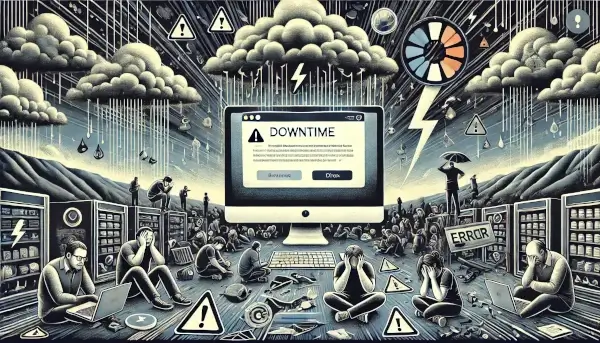
Website downtime can have several significant negative impacts on businesses and organizations. Here are the key areas affected:
Financial Losses
Direct Revenue Loss
For e-commerce websites, downtime directly translates to lost sales. If customers cannot access the site to make purchases, the company misses out on potential revenue.
Subscription-based services may experience a loss of new sign-ups and cancellations from existing users who encounter service interruptions.
Increased Operational Costs
Emergency repairs and troubleshooting during downtime often require additional resources and overtime pay for IT staff.
Companies may need to invest in additional infrastructure or services to prevent future downtime, which can be costly.
Service Level Agreement (SLA) Penalties
Businesses that provide services with uptime guarantees may face penalties or the need to offer compensation to clients for failing to meet SLA terms. An SLA uptime calculator can help these businesses accurately assess allowable downtime and proactively manage service levels to avoid breaches.
Damage to Reputation
Negative Public Perception
Frequent or prolonged downtime can lead to negative media coverage and social media backlash, damaging the company's public image.
Customers may share their negative experiences online, influencing potential new customers and partners.
Competitor Advantage
Competitors may use your downtime to their advantage by highlighting their reliability and attracting dissatisfied customers.
Brand Reliability
A reliable website is crucial for brand perception. Downtime can erode the perception of reliability, professionalism, and trustworthiness.
Loss of Customer Trust and Traffic
Decreased Customer Confidence
Customers expect reliable access to websites, and downtime can cause them to lose confidence in the business's ability to provide consistent service.
This loss of trust can be particularly damaging for financial services, healthcare, and other sectors where reliability is paramount.
Reduced Traffic and Engagement
Downtime can lead to a significant drop in web traffic as users turn to alternative sites.
Lower engagement rates can impact ad revenues and partnerships that rely on a consistent audience.
Long-term Customer Attrition
Repeated downtime incidents can drive away loyal customers who seek more reliable alternatives.
This attrition can have a long-term impact on customer lifetime value and overall business growth.
Understanding the Causes of Downtime
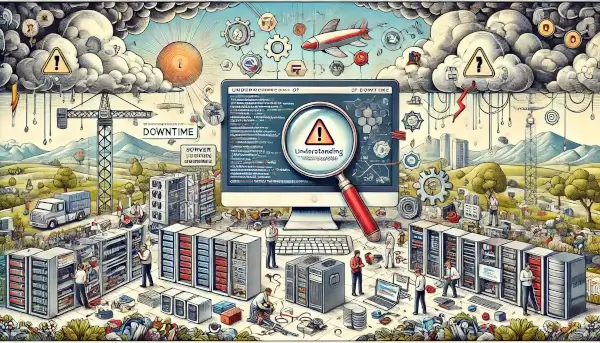
Technical issues
Technical issues are one of the primary causes of website downtime. These issues can arise from various components within the IT infrastructure, including servers, software, and network connections. Here's a closer look at each of these factors:
Server Failures
Hardware Malfunctions
Physical components of servers, such as hard drives, power supplies, or memory modules, can fail, leading to server downtime.
Overheating, electrical surges, and wear and tear over time can contribute to hardware failures.
Resource Exhaustion
Servers can become overloaded if they run out of critical resources like CPU, memory, or disk space.
High traffic volumes, unoptimized code, or insufficient hardware can lead to resource exhaustion, causing the server to crash or become unresponsive.
Configuration Errors
Incorrect server configurations can lead to failures. Misconfigured settings related to security, network, or system parameters can prevent the server from operating correctly.
Software Bugs
Application Crashes
Bugs in the website's software, including the CMS, plugins, or custom applications, can cause crashes or instability.
Incompatible software updates or poorly written code can introduce new bugs or exacerbate existing ones.
Memory Leaks
Software that doesn't properly manage memory can cause memory leaks, gradually consuming all available memory and leading to system crashes.
Memory leaks are particularly problematic in long-running processes and can be challenging to diagnose and fix.
Database Issues
Corrupt database entries, inefficient queries, or database server crashes can lead to website downtime.
High-volume transactions and inadequate database maintenance practices can exacerbate these issues.
Network Outages
Internet Service Provider (ISP) Problems
Downtime at the ISP level can interrupt the connection between users and the website.
Network outages, maintenance, or failures at the ISP can lead to extended periods of downtime.
DNS Failures
Issues with Domain Name System (DNS) configurations or servers can prevent users from reaching the website.
DNS misconfigurations, such as incorrect DNS records or propagation delays, can cause downtime.
Routing Problems
Misconfigured network routing or issues with network hardware, such as routers and switches, can disrupt the path between users and the website.
Cyber-attacks such as BGP hijacking can also lead to routing issues, causing significant downtime.
Security Breaches
Security breaches are a significant cause of website downtime, often resulting from malicious activities that disrupt normal operations. Here are the primary types of security breaches that can lead to downtime:
DDoS Attacks
Overloading Server Resources
Distributed Denial of Service (DDoS) attacks flood a website with excessive traffic from multiple sources, overwhelming the server's resources.
This excessive load can cause the server to slow down significantly or crash, rendering the website inaccessible to legitimate users.
Bandwidth Saturation
DDoS attacks can consume all available bandwidth, leaving insufficient capacity for regular traffic.
This results in slow loading times or complete inability to access the website.
Mitigation Challenges
While measures to mitigate DDoS attacks exist, such as traffic filtering and rate limiting, these defenses can be expensive and complex to implement effectively.
Sophisticated attacks can bypass basic defenses, making it crucial to have robust, layered security measures.
Hacking
Website Defacement
Hackers may gain unauthorized access to a website and alter its content, often replacing it with their own messages or images.
This leads to downtime and damages the website's reputation and user trust.
Data Breaches
Hackers can exploit vulnerabilities to access sensitive data, taking the website offline for forensic investigations and remediation.
The downtime associated with data breaches can be prolonged, as thorough security checks and patches are necessary.
System Takeover
Advanced hacking techniques can allow attackers to control the entire server or network, leading to extensive disruptions.
Ransomware attacks, where hackers lock the system and demand payment for its release, can also result in significant downtime.
Malware
Website Infection
Malware can infect a website through various means, including vulnerabilities in software, malicious downloads, or compromised third-party plugins. To properly recover from such infections, it’s essential to carry out a thorough rootkit removal process to eliminate hidden malicious components.
Infected websites often need to be taken offline to clean and remove the malware, leading to downtime.
Resource Hijacking
Certain types of malware, such as cryptojacking scripts, use server resources to mine cryptocurrencies without the owner's consent.
This unauthorized resource usage can degrade website performance and lead to crashes.
Propagation of Further Attacks
Malware can serve as a launching point for additional attacks, such as sending spam emails or launching further malware campaigns.
Such activities can lead to the website being blacklisted by search engines and security services, requiring downtime to resolve the issues and restore trust.
Human Error
Human error is another significant cause of website downtime. During configuration, deployment, or routine maintenance, mistakes can lead to unexpected outages and disruptions. Here are the key areas where human error can contribute to downtime:
Misconfigurations
Server and Network Settings
Incorrect configurations of servers and network equipment can lead to inaccessibility or degraded performance.
Examples include misconfigured firewalls blocking legitimate traffic, incorrect DNS settings leading to domain resolution failures, or improper load balancer settings causing uneven traffic distribution.
Security Settings
Inadequate or overly restrictive security settings can leave the website vulnerable to attacks or prevent legitimate access.
Common issues include misconfigured SSL certificates, incorrect user permissions, or failure to configure security protocols properly.
Database Misconfigurations
Errors in database settings, such as incorrect database connections or poorly optimized queries, can lead to slow performance or complete database crashes.
Misconfigured backup settings can also result in data loss or extended recovery times.
Poor Deployment Practices
Insufficient Testing
Deploying updates or new features without adequate testing can introduce bugs and vulnerabilities that lead to downtime.
Changes should be thoroughly tested in a staging environment that mirrors the production environment to catch issues before they affect users.
Uncoordinated Changes
Implementing changes without proper coordination can lead to conflicts and system failures.
Deployment practices should follow a structured process with clear communication and documentation, including version control and change management protocols.
Rollout Failures
Deploying updates all at once rather than using a phased rollout approach can amplify the impact of any issues.
A gradual deployment allows for monitoring and rollback if problems arise, minimizing potential downtime.
Lack of Automation
Manual deployment processes are more prone to errors than automated ones.
Using automation tools for deployment, configuration management, and continuous integration/continuous deployment (CI/CD) can reduce the risk of human error.
Inadequate Monitoring
Failing to monitor the deployment process and the website's performance can delay the detection and resolution of issues.
Continuous monitoring and logging should be part of the deployment process to ensure quick identification and troubleshooting of problems.
External Factors
External factors beyond the control of the organization can also cause website downtime. These factors include natural disasters and power outages, which can disrupt the physical infrastructure and
connectivity essential for maintaining website availability.
Natural Disasters
Extreme Weather Conditions
Hurricanes, floods, earthquakes, and tornadoes can damage data centers, communication lines, and other critical infrastructure.
Severe weather can lead to prolonged outages if data centers are physically damaged or inaccessible.
Geographical Risks
Data centers located in areas prone to natural disasters face higher risks.
Organizations must consider geographical risks when selecting data center locations and should implement disaster recovery plans that include data centers in multiple regions to mitigate these risks.
Recovery and Response Times
The aftermath of a natural disaster can result in extended downtime due to the time required for repairs and restoration.
Efficient disaster recovery plans and rapid response strategies are essential to minimize downtime and resume normal operations as quickly as possible.
Power Outages
Grid Failures
Power outages caused by failures in the electrical grid can lead to immediate and unexpected downtime if data centers and servers lose power.
Various issues, including equipment failure, accidents, or sabotage, can cause such outages.
Insufficient Backup Power
While many data centers use backup generators and uninterruptible power supplies (UPS) to maintain operations during power outages, these systems can fail or run out of fuel if the outage is prolonged.
Regular maintenance and testing of backup power systems are crucial to ensure their reliability when needed.
Local Power Interruptions
Power interruptions locally, such as construction accidents cutting power lines or local transformer failures, can also disrupt website operations.
Data centers must have contingency plans to handle local power interruptions effectively.
Preventive Measures
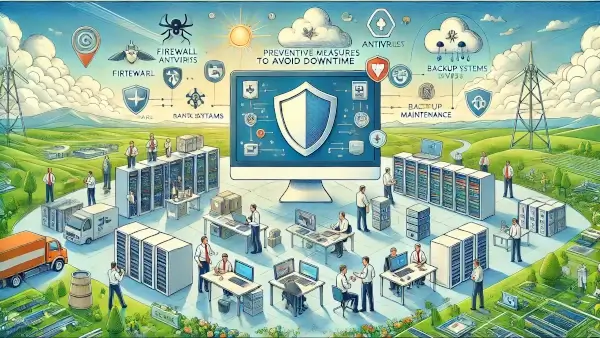
Choosing a Reliable Hosting Provider
Selecting a reliable hosting provider is a crucial step in minimizing website downtime. A dependable host ensures your website remains accessible and performs well under various conditions. Here are the key criteria for selecting a reliable hosting provider and the importance of uptime guarantees and Service Level Agreements (SLAs).
Criteria for Selecting a Dependable Host
Reputation and Reviews
Research the hosting provider's reputation by reading reviews and testimonials from current and past customers.
Look for consistent positive feedback regarding uptime, customer support, and reliability.
Performance and Speed
Ensure the hosting provider offers high-performance servers with fast load times.
Check for the use of modern technologies such as SSD storage, CDN integration, and caching mechanisms to enhance performance.
Security Features
A reliable host should offer robust security measures, including firewalls, DDoS protection, regular security audits, and SSL certificates.
Ensure they provide automated backups and recovery options to protect against data loss.
Scalability
Choose a hosting provider with scalable solutions to accommodate your website's growth.
Look for options to easily upgrade resources like CPU, RAM, and storage as your traffic increases.
Customer Support
Reliable customer support is critical for addressing issues promptly. Ensure the hosting provider offers 24/7 support through multiple channels such as phone, email, and live chat.
Evaluate the quality of their support by reading reviews and testing their responsiveness with pre-sales questions.
Data Center Locations
The physical location of data centers can affect website speed and latency. Choose a hosting provider with data centers close to your target audience.
Providers with multiple data centers offer better redundancy and disaster recovery options.
Importance of Uptime Guarantees and SLAs
Uptime Guarantees
Uptime guarantees specify the minimum percentage of time the hosting provider ensures your website will be accessible. A common industry standard is 99.9% uptime, equating to less than 45 minutes of monthly downtime.
Hosting providers that offer strong uptime guarantees are typically more reliable and invested in maintaining high service standards.
Service Level Agreements (SLAs)
SLAs are formal agreements between you and the hosting provider outlining the expected service level, including uptime guarantees, performance metrics, and support response times.
An SLA holds the provider accountable and often includes compensation or credits if they fail to meet the agreed-upon standards.
Monitoring and Reporting
Reliable hosting providers continuously monitor their infrastructure and provide customers with detailed uptime reports.
Access to these reports allows you to verify the provider's performance and uptime claims, ensuring transparency and trust.
Compensation for Downtime
SLAs typically include provisions for compensation if the provider fails to meet the uptime guarantees. This can be in the form of service credits or partial refunds.
Knowing that there are financial consequences for the provider incentivizes them to minimize downtime and prioritize your website's availability.
Regular Software Updates
Regular software updates are essential in maintaining website security, performance, and reliability. Keeping your server operating system (OS), content management system (CMS), and plugins up to date helps protect against vulnerabilities and ensures optimal functionality. Here are the key aspects of regular software updates and the benefits of automated update tools.
Keeping Server OS, CMS, and Plugins Up to Date
Server Operating System (OS)
Security Patches — The server OS's regular updates include security patches that address known vulnerabilities. Keeping the OS up to date is crucial to protecting against potential exploits and attacks.
Performance Enhancements — Updates often include improvements that can enhance server stability and efficiency, leading to better website performance.
CompatibilityAn updated server OS ensures compatibility with the latest software, drivers, and technologies, preventing potential conflicts and issues.
Content Management System (CMS)
Security Fixes — CMS updates frequently address security vulnerabilities that attackers could exploit. Staying current with updates reduces the risk of your website being compromised.
Feature Improvements — CMS updates often include new features and improvements that can enhance your website's functionality and user experience.
Bug Fixes — Updates fix known bugs and issues, ensuring the CMS operates smoothly and efficiently.
Plugins and Extensions
Security Updates — Plugins are common targets for attackers. Regularly updating plugins ensures that any security vulnerabilities are patched promptly.
Compatibility and Stability — Plugin updates maintain compatibility with the latest CMS and server OS versions, preventing conflicts and ensuring stable operation.
Enhanced Features — Developers often add new features and enhancements to plugins, which can improve website functionality and user experience.
Benefits of Using Automated Update Tools
Efficiency and Time-Saving
Automated Processes — Automated update tools streamline the process of checking for and applying updates, saving time and reducing the manual effort required to keep software current.
Scheduled Updates — These tools can schedule updates during off-peak hours, minimizing the impact on website availability and performance.
Consistency and Reliability
Regular Intervals — Automated tools ensure updates are applied consistently and regularly, reducing the risk of missing critical updates due to oversight or delays.
Reduced Human Error — Automation minimizes the risk of human error during the update process, such as incorrect configurations or missed updates.
Improved Security
Timely Updates — Automated tools can promptly apply security patches and updates as soon as they are released, minimizing the window of vulnerability.
Comprehensive Coverage — These tools can simultaneously manage updates across multiple components (OS, CMS, plugins), ensuring comprehensive protection.
Enhanced Monitoring and Reporting
Update Logs — Automated update tools often provide detailed logs and reports of update activities, allowing you to monitor the status and success of updates.
Alerts and Notifications — Many tools offer alerts and notifications for failed updates or issues, enabling prompt intervention and resolution.
Implementing Redundancy
Redundancy is a critical strategy for minimizing website downtime and ensuring continuous availability. By implementing redundancy, you can create multiple layers of backup and failover systems to keep your website operational even in the event of a failure. Here are key components of redundancy, including load balancing, backup servers, and failover systems.
Load Balancing
Load balancing distributes incoming network traffic across multiple servers to ensure no single server becomes overwhelmed. This helps to optimize resource use, maximize throughput, and minimize response time.
Load balancing enhances the reliability and availability of your website by spreading the load and preventing any single point of failure.
Types of Load Balancers
- Hardware Load Balancers: Physical devices that manage traffic distribution at the hardware level, offering high performance and reliability.
- Software Load Balancers: These applications run on standard servers, providing flexibility and easy integration with existing infrastructure.
- Cloud-based Load Balancers: Services provided by cloud platforms (e.g., AWS Elastic Load Balancing, Google Cloud Load Balancing) that offer scalable and distributed traffic management.
Benefits of Load Balancing
- Improved Performance: Load balancing prevents server overload by distributing traffic evenly, ensuring fast and consistent response times.
- Enhanced Scalability: Load balancers can easily integrate additional servers to handle increased traffic, supporting website growth.
- Fault Tolerance: If one server fails, the load balancer redirects traffic to healthy servers, maintaining website availability.
Backup Servers
Purpose of Backup Servers
Backup servers act as a safeguard against hardware failures, data corruption, and other disruptions by providing an alternative server that can take over if the primary server fails.
Regularly updated backups ensure that data and services can be quickly restored with minimal loss.
Types of Backup Servers
- Cold Backup: Servers that are only activated in the event of a failure. This is a cost-effective but slower recovery option since the backup server needs to be brought online and synchronized.
- Warm Backup: Servers that are partially active and regularly updated, allowing for faster switchover in case of failure.
- Hot Backup: Fully operational servers that continuously mirror the primary server, enabling instant failover with no downtime.
Implementing Backup Servers
Regular Backups — Schedule regular backups of data and configurations to ensure the backup server is up-to-date.
Automated Syncing — Automated tools are used to synchronize data between primary and backup servers in real-time or at regular intervals.
Testing and Maintenance — Regularly test backup servers to ensure they can take over without issues and perform maintenance to keep them ready.
Failover Systems
Failover systems automatically switch to a standby server or network upon the failure of the primary system, ensuring continuous service availability.
They are critical for maintaining uptime during unexpected failures or maintenance activities.
Components of Failover Systems
- Failover Clustering: A group of servers (cluster) that work together, with failover capabilities allowing one server to take over if another fails.
- DNS Failover: DNS services that automatically redirect traffic to backup servers or data centers in case of a primary server failure.
- Database Replication: Synchronizing databases across multiple servers to ensure data consistency and availability in case of failover.
Implementing Failover Systems
Automated Monitoring: Continuously monitor server health and performance to detect failures and trigger failover processes.
Redundant Network Paths: Ensure multiple network connections and paths to avoid single points of failure in connectivity.
Failover Testing: Regularly test failover mechanisms to ensure they work correctly and efficiently, minimizing downtime during failures.
Monitoring and Alerts
Effective monitoring and alerting systems are crucial for maintaining website uptime and promptly addressing any issues that may arise. Continuous monitoring ensures potential problems are detected early, allowing swift action to minimize downtime. Here's a detailed look at the importance of 24/7 monitoring and the tools available for real-time monitoring and alerting.
Importance of 24/7 Monitoring
Continuous Vigilance
24/7 monitoring ensures that your website is continuously watched for any signs of trouble, regardless of the time of day. This constant vigilance is essential for promptly detecting and responding to issues before they escalate.
It helps identify patterns or recurring issues that could indicate underlying problems, allowing for proactive maintenance and prevention.
Rapid Response to Issues
Continuous monitoring enables immediate detection of downtime, performance degradation, or security breaches, allowing your IT team to respond quickly and minimize impact.
Faster response times can significantly reduce the duration of downtime and the potential losses associated with it.
User Experience and Satisfaction
Consistent uptime and quick resolution of issues contribute to a positive user experience, maintaining customer satisfaction and trust.
Users expect websites to be always available and responsive, and 24/7 monitoring helps meet these expectations.
Compliance and SLAs
Many industries have compliance requirements that mandate continuous monitoring of critical systems. Failing to meet these requirements can result in penalties.
Adhering to Service Level Agreements (SLAs) with uptime guarantees often requires robust monitoring to ensure these commitments are met.
Tools for Real-Time Monitoring and Alerting
The tools for real-time monitoring and alerting can be categorized as follows:
- Application Performance Monitoring (APM) Tools — essential for ensuring software applications' optimal performance, reliability, and availability. These tools provide comprehensive insights into application health and performance, allowing organizations to detect and resolve issues before they impact end users.
- Infrastructure Monitoring Tools — essential for ensuring an organization's IT infrastructure's reliability, performance, and availability. These tools provide comprehensive insights into the health and status of various infrastructure components, including servers, networks, storage, and virtual environments.
- Cloud-Based Monitoring Solutions — designed to oversee the performance, availability, and health of applications and infrastructure deployed in cloud environments. These solutions leverage the scalability and flexibility of the cloud to provide real-time insights and alerts for cloud resources and services.
- Website Uptime Monitoring Tools — essential for ensuring websites remain accessible and perform optimally. These tools help detect and respond promptly to downtime or performance issues, minimizing disruptions for end users.
- Security Monitoring Tools — designed to continuously monitor IT infrastructure, applications, and networks for security threats, vulnerabilities, and compliance issues. These tools help organizations detect, respond to, and mitigate potential security incidents in real time.
- Alerting and Incident Management Platforms — crucial for efficiently handling IT and operational incidents. These tools help organizations detect issues, notify the right personnel, and manage the resolution process systematically.
Security Enhancements
Implementing robust security enhancements is essential to protect websites from potential threats and ensure continuous availability. Key security measures include firewalls, DDoS protection, regular security audits, and vulnerability assessments. Here's a detailed look at these security enhancements:
Firewalls and DDoS Protection
Firewalls
Firewalls are a barrier between your internal network and external threats, controlling incoming and outgoing traffic based on predetermined security rules.
The types of firewalls include:
- Network Firewalls: Protect entire networks by filtering traffic at the network level.
- Web Application Firewalls (WAF): Specifically designed to protect web applications by filtering and monitoring HTTP traffic.
Ensure firewalls are correctly configured to block unauthorized access while allowing legitimate traffic. Regularly update firewall rules to adapt to evolving threats.
DDoS Protection
DDoS (Distributed Denial of Service) protection prevents overwhelming traffic from disrupting your website. DDoS attacks involve flooding a website with excessive requests, causing it to slow down or crash.
The types of DDoS protection include:
- Network-Based DDoS Protection: This combination of hardware and cloud-based services detects and mitigates DDoS attacks.
- Application-Based DDoS Protection: Focuses on protecting specific applications from targeted attacks.
Employ DDoS protection services that offer real-time traffic analysis, rate limiting, and automated threat mitigation to ensure continuous website availability during an attack.
Regular Security Audits and Vulnerability Assessments
Security Audits
Security audits comprehensively evaluate an organization's security policies, procedures, and controls. They identify weaknesses and ensure compliance with security standards.
The types of security audits include:
- Internal Audits: Conducted by in-house security teams to assess internal practices and policies.
- External Audits: Performed by third-party organizations to provide an unbiased security posture assessment.
Schedule regular security audits to review and update security measures, ensuring they remain effective against new and emerging threats. Document findings and implement recommended improvements promptly.
Vulnerability Assessments
Vulnerability assessments involve scanning systems, networks, and applications for security weaknesses that attackers could exploit.
The types of vulnerability assessments include:
- Automated Scans: Use specialized tools to identify known vulnerabilities in software and configurations.
- Manual Assessments: Conducted by security experts to identify complex vulnerabilities that automated tools might miss.
Perform regular vulnerability assessments and prioritize fixing identified issues based on their severity. Use both automated tools and manual techniques to ensure comprehensive coverage.
Proper Backup Strategies
Proper backup strategies are essential to ensure data integrity, recoverability, and business continuity during data loss or system failure. Here are the key components of effective backup strategies, including regular data backups and off-site storage solutions:
Regular Data Backups
Frequency of Backups
Daily Backups — Perform daily backups of critical data to ensure that recent changes are captured. This is particularly important for databases, customer information, and transaction records.
Incremental Backups — Implement incremental backups that capture only the changes made since the last backup, reducing the time and storage space required compared to full backups.
Weekly and Monthly Full Backups — Schedule weekly and monthly full backups to create comprehensive snapshots of the entire system, providing a complete recovery point.
Automation
Automated Backup Solutions — Use automated backup tools and scripts to schedule regular backups, ensuring consistency and reducing the risk of human error.
Backup Monitoring — Implement monitoring systems to verify the success of backup operations and alert administrators to any failures or issues.
Versioning and Retention
Retain multiple backup versions to protect against data corruption or accidental deletions. This allows restoration from a previous version if recent backups are compromised.
Establish clear retention policies that define how long different types of backups are kept, balancing the need for historical data with storage costs.
Data Integrity Checks
Periodically test backup integrity and restoration processes to ensure that backups are complete, uncorrupted, and can be restored quickly in an emergency.
Checksums and other verification methods also detect data corruption in backups, ensuring data integrity.
Off-Site Storage Solutions
Geographical Redundancy
Store backups in a geographically different location from the primary data center to protect against local disasters like fires, floods, or earthquakes.
Utilizing cloud-based storage services for off-site backups is also a good idea, as they benefit from the cloud's scalability, accessibility, and built-in redundancy.
Physical Media Storage
Use external hard drives and tapes for critical data, and consider using external hard drives or tape backups stored in secure off-site facilities. Ensure these media are regularly updated and rotated.
Ensure physical media are transported securely to off-site locations and stored in environments that protect against physical damage and unauthorized access.
Cloud Backup Services
Leverage cloud backup services that offer automated, scalable, and secure storage options. These services often include encryption, redundancy, and easy access to backup data.
Consider DRaaS providers that offer comprehensive disaster recovery solutions, including cloud backups, failover capabilities, and rapid recovery options.
Encryption and Security
Encrypt backup data in transit and at rest to protect against unauthorized access and ensure data confidentiality.
Implement strict access controls and authentication measures for backup systems, limiting access to authorized personnel only.
Human Error Mitigation
Human error is a significant cause of website downtime and other IT-related issues. Implementing strategies to mitigate human error can significantly enhance the reliability and stability of your IT infrastructure. Key measures include training for IT staff and implementing change management processes. Here's how these strategies can help:
Training for IT Staff
Regular Training Programs
Conduct regular training sessions to keep IT staff updated on the latest technologies, tools, and best practices. This helps ensure they are well-equipped to manage and troubleshoot the systems effectively.
Train staff on security protocols and threat awareness to reduce the risk of accidental security breaches caused by human error.
Use real-world scenarios and simulations to train staff on handling emergencies and troubleshooting common issues, improving their problem-solving skills under pressure.
Certification and Continuing Education
Encourage and support staff in obtaining relevant certifications (e.g., CompTIA, Cisco, Microsoft) that validate their expertise and knowledge in specific areas.
Promote continuous learning through workshops, webinars, and courses to keep staff abreast of industry trends and emerging technologies.
Knowledge Sharing and Collaboration
Organize regular internal workshops where staff can share knowledge, discuss challenges, and learn from each other's experiences.
Maintain comprehensive documentation of systems, procedures, and troubleshooting guides that staff can refer to, ensuring consistency and reducing the likelihood of errors.
Onboarding Programs
Implement structured onboarding programs for new hires, ensuring they are thoroughly familiar with the organization's systems, protocols, and best practices from the start.
Pair new employees with experienced mentors who can guide them through the initial learning phase, providing support and knowledge transfer.
Implementing Change Management Processes
Structured Change Management
Implement a formal change request system where all proposed changes must be documented, reviewed, and approved before implementation.
Establish a CAB to evaluate proposed changes' potential impact and risks, ensuring thorough assessment and informed decision-making.
Risk Assessment and Planning
Conduct impact analysis to understand the potential effects of changes on the system, identifying any risks or dependencies that need to be addressed.
Develop rollback plans for every change, ensuring any adverse effects can be quickly reversed to minimize downtime and disruption.
Testing and Validation
Ensure all changes are thoroughly tested in a staging environment that mirrors the production setup before deployment. This helps identify and resolve issues before they affect live systems.
Involve end-users in testing to validate that changes meet their needs and function as expected in real-world scenarios.
Communication and Coordination
Establish clear protocols for notifying all relevant stakeholders of planned changes, ensuring they are aware and prepared for potential impacts.
Hold regular coordination meetings with IT teams to discuss upcoming changes, share insights, and align on implementation strategies.
Post-Implementation Review
Monitor systems closely, following any changes to quickly identify and address any unforeseen issues.
Conduct post-mortem analyses of changes, documenting what went well and what could be improved for future reference.
Response and Recovery

Developing a Disaster Recovery Plan
A disaster recovery plan (DRP) is critical to an organization's strategy to ensure business continuity and minimize downtime during unexpected events. Developing a comprehensive DRP involves identifying potential risks, creating detailed response strategies, and ensuring the plan remains effective through regular testing and updates. Here are the key components of a disaster recovery plan and the importance of testing and updating the plan regularly.
Key Components of a Disaster Recovery Plan
Risk Assessment and Business Impact Analysis (BIA)
Identify potential threats that could cause significant disruptions, such as natural disasters, cyberattacks, hardware failures, and human error.
Evaluate the potential impact of different types of disasters on business operations, including financial losses, reputational damage, and operational disruptions. Prioritize critical systems and functions that need to be restored first.
Recovery Objectives
Recovery Time Objective (RTO) — Define the maximum acceptable downtime for each critical system or function. This will determine how quickly systems need to be restored to minimize impact.
Recovery Point Objective (RPO) — Determine the maximum acceptable amount of data loss measured in time. This helps define the frequency of backups and data replication strategies.
Disaster Recovery Team
Establish a disaster recovery team with clear roles and responsibilities. Assign team members specific tasks such as communication, data recovery, and system restoration.
Maintain an updated list of contact information for all team members, key personnel, vendors, and external partners involved in the recovery process.
Communication Plan
Internal Communication — Develop a strategy for communicating with employees during a disaster, including how to disseminate information about the situation, recovery efforts, and instructions.
External Communication — Plan how to communicate with customers, partners, and stakeholders. Prepare templates for public statements and updates to ensure consistent messaging.
Data Backup and Recovery
Define a comprehensive backup strategy that includes regular backups of critical data, systems, and configurations. Ensure backups are stored securely and easily accessible.
Document detailed procedures for recovering data from backups, including the tools and methods to be used and the order in which data should be restored.
Infrastructure and Systems Recovery
Develop step-by-step procedures for restoring hardware, software, network infrastructure, and applications. Include instructions for reconfiguring systems and verifying functionality.
Identify alternative locations for operations if the primary site is unusable. This may include secondary data centers, cloud-based environments, or temporary office spaces.
Vendor and Supplier Coordination
Maintain a list of critical vendors and suppliers with contact details and service agreements. Ensure they know your disaster recovery needs and can provide support during an incident.
Review and update SLAs to ensure they align with your disaster recovery objectives, particularly regarding response times and support availability.
Testing and Updating the Plan Regularly
Regular Testing
Regular simulation exercises and disaster recovery drills should be conducted to test the effectiveness of the DRP. These exercises should mimic realistic disaster scenarios to evaluate the recovery team's readiness and the recovery procedures' functionality.
Periodically test different components of the DRP, such as data recovery, system failover, and communication protocols, to identify weaknesses and areas for improvement.
Updating the Plan
After each test or drill, perform a thorough review to identify any issues or gaps in the DRP. Update the plan to address these findings and improve overall effectiveness.
Schedule regular updates to the DRP to reflect changes in business operations, technology, and external threats. Ensure that contact information, recovery procedures, and backup strategies are current.
Integrate the DRP with the organization's change management processes to ensure that any changes in the IT environment or business operations are reflected in the recovery plan.
Continuous Improvement
Establish a feedback loop to gather input from the disaster recovery team and other stakeholders after each test or disaster event. Use this feedback to refine and enhance the DRP.
Provide ongoing training for the disaster recovery team and other relevant personnel to ensure they are familiar with the DRP and their roles in recovery. Increase awareness across the organization about the importance of disaster recovery planning.
Immediate Response Procedures
When website downtime occurs, having clear and immediate response procedures is crucial to minimize the impact and restore normal operations as quickly as possible. Effective response involves technical steps to resolve issues and communication strategies to keep customers informed. Here are the steps to take during downtime and communication strategies with customers.
Steps to Take During Downtime
1. Identify the Problem
Pay attention to alerts from monitoring systems that indicate downtime or performance issues. Then, the situation can be quickly assessed to understand the scope and potential cause of the downtime. Identify whether the problem is due to hardware failure, software bugs, network issues, security breaches, or other factors.
2. Assemble the Response Team
Immediately alert the disaster recovery team and other relevant personnel to begin the response process.
Ensure each team member understands their role and tasks in resolving the issue, such as troubleshooting, communicating with stakeholders, and managing public relations.
3. Implement Troubleshooting and Resolution
Identify the affected systems and isolate them to prevent further impact. This might involve taking affected servers offline, disconnecting compromised systems, or reconfiguring network settings.
Apply necessary fixes based on the identified cause, such as rebooting servers, restoring from backups, rolling back recent changes, applying patches, or mitigating security breaches. Continuously monitor the affected systems to ensure the applied fixes are effective and to detect any further issues.
4. Restore Services
Gradually bring systems back online, starting with the most critical services. Ensure that each component is functioning correctly before proceeding to the next. Verify that all systems and applications are working as expected. Conduct tests to ensure full functionality and performance are restored.
Communication Strategies with Customers
Notify customers as soon as possible about the downtime, even if you don't have all the details yet. Early communication helps manage expectations and reduce frustration. Use multiple channels to reach customers, such as email, social media, website banners, and customer support notifications.
Clearly state that you are aware of the downtime and are actively working to resolve it. Explain what services are affected and how they may impact customers. Avoid technical jargon; keep the explanation clear and straightforward.
Provide regular updates on the status of the resolution efforts, even if there is no new information. This keeps customers informed and reassured that progress is being made. If possible, give an estimated time for when services will be restored. If the timeline changes, communicate this promptly.
Notify customers immediately once the issue has been resolved and services are fully restored. Briefly summarize what caused the downtime and the steps taken to fix it. This transparency helps rebuild trust and demonstrates accountability.
Offer an apology for the inconvenience caused by the downtime. Consider offering compensation, such as discounts, credits, or extended subscriptions, depending on the impact. Encourage customers to provide feedback on how the downtime and communication were handled. Use this feedback to improve future response procedures.
Post-Downtime Analysis
Post-downtime analysis is critical in understanding the causes of downtime, evaluating the response, and implementing improvements to prevent future occurrences. This process involves conducting a root cause analysis and implementing lessons learned. Here's a detailed look at these components.
Root Cause Analysis
Incident Documentation
Create a detailed timeline of events leading up to, during, and after the downtime. Include all relevant data, such as system logs, monitoring alerts, and incident response actions. Document the incident comprehensively, covering the initial detection, response steps, communication efforts, and eventual resolution.
Identifying the Root Cause
Gather all pertinent information and data from systems, logs, monitoring tools, and personnel involved in the incident. Structured analysis techniques such as the Five Whys, Fishbone Diagram (Ishikawa), or Fault Tree Analysis are used to identify the underlying causes of downtime systematically. Identify the immediate cause and contributing factors, such as system vulnerabilities, procedural weaknesses, or external influences.
Stakeholder Involvement
Conduct interviews and meetings with all stakeholders involved in the incident, including IT staff, developers, security teams, and customer support.
Ensure a cross-functional review of the incident to get diverse perspectives and insights into the root cause.
Implementing Lessons Learned to Prevent Future Occurrences
1. Developing Action Plans
Define specific corrective actions to address the identified root cause and contributing factors. These actions should aim to eliminate or mitigate the risks that led to the downtime. Implement preventive measures such as enhanced monitoring, updated security protocols, improved redundancy, or refined operational procedures.
2. Updating Policies and Procedures
Revise existing policies and procedures based on the findings from the root cause analysis. Ensure that these updates address the weaknesses identified during the incident. Update all relevant documentation, including incident response plans, disaster recovery plans, and standard operating procedures, to reflect the new changes.
3. Training and Awareness
Conduct training sessions for IT staff and other relevant personnel to familiarize them with the new policies, procedures, and preventive measures. Implement awareness programs to ensure all employees understand the importance of following updated protocols and the lessons learned from the incident.
4. Enhanced Monitoring and Testing
Upgrade monitoring tools and techniques to provide better visibility into system performance and potential issues. Implement advanced analytics and real-time alerting to detect anomalies earlier.
Regular tests and drills should be conducted to ensure the updated procedures and systems work as expected. This includes disaster recovery drills, failover tests, and security penetration testing.
5. Feedback Loop
Establish a feedback loop to continuously assess the effectiveness of the implemented changes and make further adjustments as needed.
Schedule regular post-mortem reviews for future incidents, using the same root cause analysis and lesson implementation approach to build a culture of continuous improvement.
6. Communication with Stakeholders
Share the post-downtime analysis findings and the steps to prevent future occurrences with all internal stakeholders. This transparency fosters a culture of accountability and continuous learning.
Communicating with customers about the steps to address downtime and prevent future incidents is also a good idea. This can help rebuild trust and demonstrate your commitment to reliability.
Best Practices
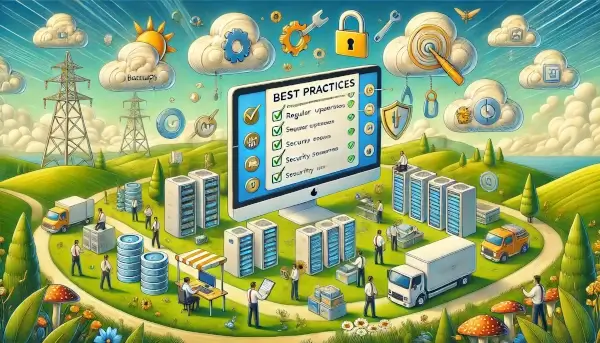
Proactive Maintenance
Proactive maintenance is crucial for preventing unexpected downtime and ensuring the smooth operation of IT infrastructure. By scheduling regular maintenance windows and implementing pre-emptive updates and fixes, organizations can address potential issues before they become critical problems. Here are the key aspects of proactive maintenance:
Regularly Scheduled Maintenance Windows
Planning and Scheduling
Develop a comprehensive maintenance calendar that outlines regular maintenance windows. Schedule these windows during off-peak hours to minimize disruption to users. Determine the frequency of maintenance windows based on the criticality of the systems and historical data on system performance and failures. Common intervals include weekly, monthly, or quarterly maintenance.
Communication and Coordination
Provide advance notice to all stakeholders, including employees, customers, and partners, about upcoming maintenance windows. Use multiple communication channels such as emails, alerts, and announcements on the website. Explain what to expect during the maintenance window, including which services will be affected and for how long.
Maintenance Tasks
Apply software patches, firmware updates, and security fixes to servers, applications, and network devices.
Perform hardware inspections and replace or repair any components showing wear and tear.
Optimize system configurations, clean up temporary files, and ensure optimal performance of databases and applications.
Verify the integrity of backups and ensure they are up-to-date and accessible.
Documentation and Review
Keep detailed logs of all maintenance activities, including tasks performed, issues encountered, and resolutions implemented. Conduct a review after each maintenance window to assess the activities' effectiveness and identify areas for improvement.
Importance of Pre-Emptive Updates and Fixes
Security Enhancements
Apply security patches and updates regularly to address known vulnerabilities. This reduces the risk of security breaches that could lead to downtime or data loss. Implement pre-emptive measures such as intrusion detection systems (IDS) and intrusion prevention systems (IPS) to detect and mitigate potential threats before they cause harm.
Performance Optimization
Continuously monitor system performance and resource utilization to identify and address potential bottlenecks before they impact users.
Manage resources such as CPU, memory, and storage proactively to ensure systems operate efficiently and handle peak loads.
Reliability and Stability
Use predictive analytics and monitoring tools to predict and prevent hardware failures. Replace or service components showing early signs of failure. Regularly update software to the latest stable versions to benefit from new features, performance improvements, and bug fixes.
Compliance and Standards
Ensure systems comply with industry standards and regulatory requirements by applying necessary updates and fixes.
Adhere to industry best practices for system maintenance and updates, which help maintain the reliability and security of IT infrastructure.
Continuous Improvement
Gather feedback from maintenance activities and update maintenance procedures accordingly. Adapt to new technologies and emerging threats to stay ahead. Provide ongoing training for IT staff on the latest maintenance practices, tools, and technologies to ensure they can perform effective pre-emptive maintenance.
Performance Optimization
Performance optimization ensures that websites and applications run smoothly and efficiently, providing a positive user experience. Key aspects of performance optimization include optimizing server performance and leveraging Content Delivery Networks (CDNs) and caching mechanisms. Here's how these strategies can be effectively implemented:
Optimizing Server Performance
Resource Management
Ensure that server resources such as CPU and memory are adequately allocated based on your applications' needs. Regularly monitor resource usage to identify and address bottlenecks.
Implement load balancing to distribute traffic evenly across multiple servers, preventing any single server from becoming overwhelmed and ensuring high availability.
Server Configuration
Configure server settings to maximize performance, such as adjusting thread pools, connection limits, and buffer sizes. Disable unnecessary background processes and services that consume resources, freeing up capacity for critical application processes.
Database Optimization
Use indexing to speed up database queries, reducing the time it takes to retrieve data. Analyze and optimize database queries to ensure they run efficiently. Avoid complex, resource-intensive queries where possible.
To ensure optimal performance, perform regular database maintenance tasks such as defragmentation, statistics updates, and consistency checks.
Application Optimization
Write clean, efficient code and refactor regularly to remove bottlenecks. Use profiling tools to identify and resolve performance issues in the codebase.
Implement asynchronous processing for tasks that don't need to be executed immediately, reducing the load on the server.
Monitoring and Analysis
Use performance monitoring tools to track server and application performance metrics continuously. Identify trends and potential issues before they impact users.
Analyze server logs to detect performance issues, errors, and unusual patterns that could indicate underlying problems.
Importance of CDN and Caching
Content Delivery Networks (CDNs)
CDNs distribute content across a geographically dispersed server network, ensuring users access the content from the nearest server. This reduces latency and improves load times. CDNs handle large volumes of traffic by offloading requests from the origin server, enhancing the website's ability to scale and manage spikes in traffic. By distributing content across multiple locations, CDNs provide redundancy, ensuring that content remains available even if one or more servers fail.
Caching Mechanisms
Enable browser caching to store static files such as images, CSS, and JavaScript locally on users' devices. This reduces the need to re-download unchanged content, speeding up load times.
Implement server-side caching strategies, such as object caching, page caching, and opcode caching, to reduce the server's load and speed up response times.
- Object Caching: Cache frequently accessed objects in memory to reduce database load and improve retrieval times.
- Page Caching: Cache entire pages or page fragments to serve static content quickly, bypassing the need for dynamic content generation on each request.
- Opcode Caching: Cache compiled PHP code to avoid repeated parsing and compilation, improving the performance of PHP-based applications.
Edge Caching
Utilize edge servers CDNs provide to cache content closer to the end users, further reducing latency and improving performance.
Employ techniques to cache dynamic content intelligently, using rules and conditions to determine when to serve cached content versus fresh content.
Cache Invalidation and Expiration
Implement cache invalidation policies to ensure that outdated content is refreshed appropriately. Use cache-busting techniques for assets that change frequently.
Set appropriate expiration headers for different types of content to control how long they should be cached, balancing performance with the need for up-to-date content.
Regular Audits and Reviews
Regular audits and reviews are essential for maintaining IT systems and operations' security, efficiency, and reliability. These activities help identify potential issues, ensure compliance with standards and regulations, and keep policies and procedures up to date. Here are the key components of conducting periodic audits and reviewing and updating policies and procedures.
Conducting Periodic Audits
Scheduling and Planning
Develop a schedule for regular audits, such as quarterly, biannual, or annual, depending on the criticality of the systems and regulatory requirements. Define the scope of each audit, including which systems, processes, and controls will be examined. This helps ensure that all critical areas are reviewed systematically.
Types of Audits
- Security Audits: Assess the security posture of IT systems to identify vulnerabilities, ensure compliance with security policies, and verify the effectiveness of security controls.
- Compliance Audits: Ensure adherence to relevant laws, regulations, and industry standards (e.g., GDPR, HIPAA, PCI-DSS). This helps avoid legal penalties and maintain certification.
- Operational Audits: Evaluate the efficiency and effectiveness of IT operations, including system performance, resource utilization, and process efficiency.
- Financial Audits: Review financial controls and transactions to ensure the integrity and accuracy of financial reporting and prevent fraud.
Audit Execution
Gather relevant data through system logs, configuration files, process documentation, and interviews with key personnel. Analyze the collected data against established benchmarks, policies, and best practices to identify deviations and areas for improvement. Document the findings in a detailed audit report, highlighting strengths, weaknesses, and specific recommendations for remediation and improvement.
Follow-Up and Remediation
Develop action plans to address the issues identified during the audit. Assign responsibilities and set deadlines for implementing corrective measures. Schedule follow-up audits to verify the corrective actions have been implemented effectively and resolved the identified issues.
Reviewing and Updating Policies and Procedures
Regular Reviews
Establish a regular review cycle for policies and procedures, such as annually or biannually, to ensure they remain relevant and effective. Involve key stakeholders, including IT staff, management, and compliance officers, in the review process to gain diverse perspectives and insights.
Assessment and Evaluation
Conduct a gap analysis to compare existing policies and procedures with current best practices, regulatory requirements, and organizational needs. Assess the effectiveness of current policies and procedures in achieving their intended outcomes. Identify any areas where they may be lacking or need improvement.
Policy and Procedure Updates
Update policy and procedure documents to reflect technological changes, business processes, regulatory requirements, and organizational priorities. Implement a formal approval process for policy changes, involving review and sign-off by relevant authorities to ensure alignment with organizational goals and compliance requirements.
Communication and Training
Communicate updated policies and procedures to all relevant personnel through emails, intranet postings, and staff meetings. Ensure that everyone is aware of the changes and understands their responsibilities.
Conduct training sessions to educate employees on new or revised policies and procedures. This helps ensure compliance and proper implementation.
Continuous Improvement
Establish feedback mechanisms, such as surveys and suggestion boxes, to gather input from employees on the effectiveness and clarity of policies and procedures.
Treat policy and procedure reviews as an iterative process, continuously seeking ways to improve and adapt to changing circumstances and emerging best practices.
Conclusion
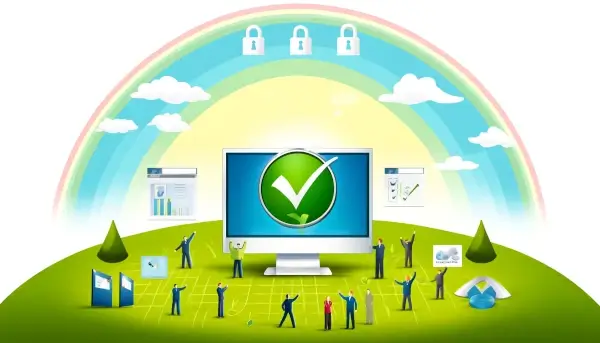
Maintaining your website's uptime and performance is not just a technical necessity but a strategic imperative. Downtime can have a profound impact on your reputation, customer trust, and bottom line. By adopting the preventive measures and best practices outlined in this article, you can create a robust framework that minimizes the risk of downtime and ensures quick recovery when issues arise.
Remember, the key to effective website management is continuous vigilance and improvement. Regular audits, proactive maintenance, and thorough training for your team are essential. Keep your systems updated, secure, and optimized, and always be prepared with a solid disaster recovery plan.
In a rapidly evolving digital landscape, staying ahead of potential issues through careful planning and execution will set your organization apart. By prioritizing uptime and reliability, you are not just protecting your business but also enhancing the experience for your users, ultimately driving long-term success and growth.
To properly recover from such infections, it’s essential to carry out a thorough rootkit removal process to eliminate hidden malicious components.


 Copyright 2000-2025, WebSitePulse. All rights reserved.
Copyright 2000-2025, WebSitePulse. All rights reserved.